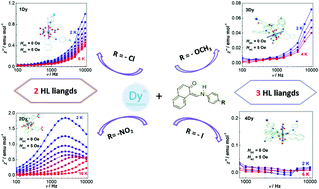Four mononuclear dysprosium complexes with neutral Schiff-base ligands: syntheses, crystal structures and slow magnetic relaxation behavior†
Abstract
Four mononuclear 9-coordinate Dy-based complexes, [Dy(HL1)2(NO3)3(CH3OH)] (1Dy), [Dy(HL2)2(NO3)3(H2O)] (2Dy), [Dy(HL3)3(NO3)3]·CH3CN (3Dy), and [Dy(HL4)3(NO3)3] (4Dy), have been constructed by neutral Schiff-base ligands (1-[N-(4-R)aminomethylidene-2(1H)-naphthalenone, R = –Cl (HL1), –NO2 (HL2), –OCH3 (HL3), –I (HL4)). By tuning the terminal substituent group of HL ligands, the number of HL ligands coordinated to the central Dy3+ ion unexpectedly varies from 2 to 3, and the local symmetry around the Dy3+ ion reduces from D3h to Cs. Magnetic measurements reveal that 2Dy can display single-ion magnet (SIM) behavior in zero dc field, while 1Dy, 3Dy and 4Dy show field-induced slow magnetic relaxation. Ab initio calculations were employed to elucidate magnetic anisotropy in the complexes, including g-tensors, averaged transition magnetic moments and magnetic easy axes. The difference in magnetic behaviors of the four complexes can be ascribed to the terminal substituent effect of neutral Schiff-base ligands.



 Please wait while we load your content...
Please wait while we load your content...